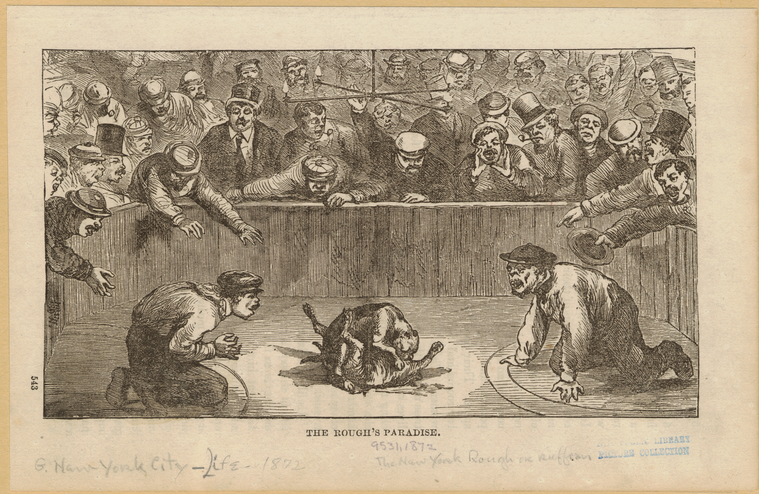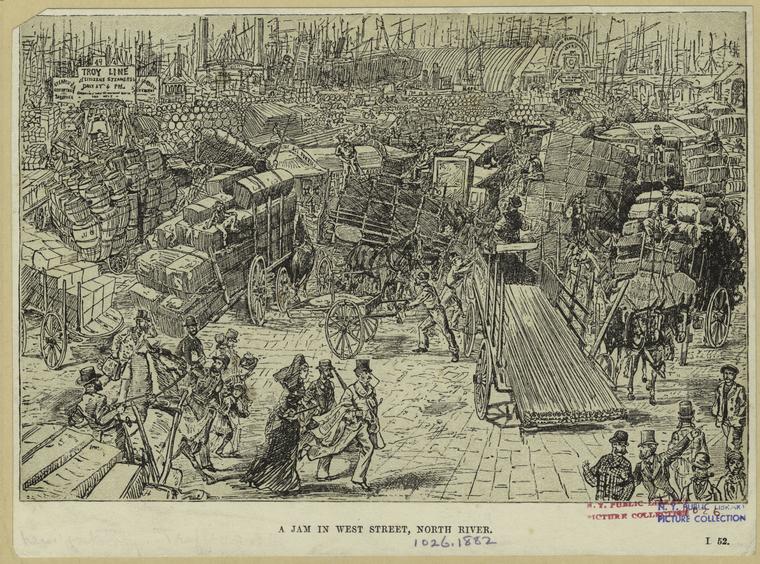Old Time Tours: New York City Guidebooks After the Civil War
This history series on 19th century New York City guidebooks is a companion to our research guide: Old Time Tours: A Guide to 19th Century NYC Guidebooks. For colonial guides to New York City, see our research guide Sea Blazers and Early Scriveners: The First Guidebooks to New York City.
-
New York City Guidebooks in the Early Republic
-
New York City Guidebooks in the Mid-1800s
-
New York City Guidebooks After the Civil War

Wartime
Published in multiple editions and updated minimally between 1859 and 1877, Miller’s New York As It Is was one of the few guidebooks published during the Civil War, including the year of the Draft Riots. At times, the author sounds like a 21st century tour guide having a bad day: “The denizens of New York are such utilitarians that they have sacrificed to the shrine of Mammon almost every relic of the olden time. The feeling of veneration for the past, so characteristic of the cities of the Old World, is lamentably deficient among the people of the New.”
One learns that it cost 10 cents to mail a letter to California; locations of police precincts are listed; and the “Supplemental Hints” section is an archetypal example of a guided walking tour, providing the traveler a recommended route. However, as Curbed NY has noted, Miller’s guide “continued to be published through the early 1880s, but critics complained that he was still describing the city as it had looked in 1859, when the first edition came out.” Miller may have been a proto-situationist.
By the 1890s—a decade which opened with a dispute over Manhattan’s population count in the federal census, and ended with the consolidation of the Greater City of New York—NYC guidebooks reflected the self-consciousness of a supercity exposing itself to the world. The most widely circulated was King's Handbook of New York City, published by Moses King.

Vice
Similar to the desuetude of Times Square in the 1970s and 1980s after the Vietnam War, a popular theme of postbellum NYC guidebooks is vice or, as one title puts it, where to find the Nether Side of New York (1872). These works often posed upon moral high ground in order to describe in detail the goings-on of underworld Gotham while seeming to both warn the innocent and condemn the lowly. Likewise, The Secrets of the Great City (1868) and Lights and Shadows of New York Life authored by James D. McCabe, Jr. (1873), and The Man-Traps of New York… By a Celebrated Detective (1881).
In the introduction to Lights and Shadows, McCabe indicates that his intended audience is people who do not live in the city and who will never get a chance to visit. “Its magnificence is remarkable,” he says, “its squalor appalling.” Customs of marriage and death are detailed, including an explanation of "matrimonial brokers," a type of deviant matchmaker and apparently a chiefly female occupation, where men paid the "broker" to find a suitable partner for "marriage," though the author refers to the women as "victims" and indicates that sometimes knockout drops were used on unpersuaded young women.
Nether Side includes chapters on "Harbor Thieves," like "Flabby" Brown and "Slip" Locksley who plotted piracy at "Slaughterhouse Point" at James and Water Streets; "Skinners," or operators of Wall Street fraud schemes involving U.S. bonds and insurance policies; and a chapter on "Abortionists," whose absolute castigation as murderers the author bases on a moral supremacy which he also then applies with equal venom upon the reasonings of the suffering women who seek out such illegal services—the majority are mothers in working-class households preventing a domestic brood in double-digits, and unmarried unwomen seduced by rich husbands in "reputable society" where pregnancy would invoke shame, exile, and destitution.

Occupational Memoir
A unique, non-lurid example in this time period is Recollections of an Old Cartman: Old New York Street Life (1872), by Isaac S. Lyon. Today, the term “carting” refers to hauling waste. In the 19th century, it referred to the horse and buggy service that people used to have stuff transported from one place to another. A cartman was required to obtain a license, and the rates charged for loading and carrying different types of items were fixed by the city. Lyons’s Recollections is not officially a guidebook, but more a reminiscence of life in New York while performing a unique job; this itself is a longstanding genre, from Recollections of a New York Chief of Police (1887), to Revelations of a Prison Doctor (1934) by Louis Berg, a former M.D. at the New York County Penitentiary and Workhouse on Welfare Island, to Kitchen Confidential (2000) by yegg celebrity chef Anthony Bourdain, who dishes on the dirtybird back kitchen of the hot-shot NYC restaurant world. This synthesis of memoir and guide, often written in a unique narrative style with the wit and eye of an insider, is found most lively in the 1920s and 1930s—titles like All About New York: An Intimate Guide by pre-Code scriptwriter and ex-reporter at the Brooklyn Daily Eagle, Rian James, or The Real New York: A Guide for the Adventurous Shopper, the Exploratory Eater and the Know-It-All Sightseer Who Ain't Seen Nothin' Yet, by adventuress newswoman Helen Worden.
In Recollections, the Old Cartman has since retired to New Jersey, and remembers the city with a gruff Victorian morality. “New York has been growing great,” he says, “without growing good.”
Read E-Books with SimplyE
 With your library card, it's easier than ever to choose from more than 300,000 e-books on SimplyE, The New York Public Library's free e-reader app. Gain access to digital resources for all ages, including e-books, audiobooks, databases, and more.
With your library card, it's easier than ever to choose from more than 300,000 e-books on SimplyE, The New York Public Library's free e-reader app. Gain access to digital resources for all ages, including e-books, audiobooks, databases, and more.
If you don’t have an NYPL library card, New York State residents can apply for a digital card online or through SimplyE (available on the App Store or Google Play).
Need more help? Read our guide to using SimplyE.


Comments
NYC guides post civil war
Submitted by B.P (not verified) on May 11, 2020 - 9:41am
Looking for info on NYU hospital and med school 1040's fertility
Submitted by Ellen N wexler (not verified) on June 22, 2020 - 10:16am